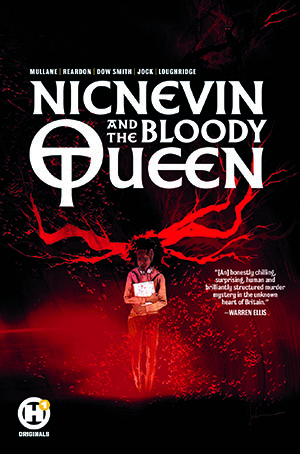Sponsored by Nicnevin and the Bloody Queen by Helen Mullane, Dom Reardon, and Matthew Dow Smith.
Something wicked is brewing in the English countryside. London teen Nicnevin “Nissy” Oswald has been banished to the British countryside for the summer with only her mother and brother for company. As she busies herself with old family relics and thoughts of the handsome neighbor, Reggie, the small, humdrum town gets rocked by a slew of grisly murders. Before long, a series of seemingly disparate yet increasingly disturbing incidents brew into a storm, and Nissy is in its eye.
Because Derek Waters of Drunk History won’t return my phonecalls, we hosted a Drunk History DIY party a couple weeks ago, and in preparation, I went DEEP into the research wormhole of Irish folklore (I wanted to talk about Bridget and Michael Cleary). Wow, y’all, that tide of terror runs deep AND wide… did you know that there are like, nine levels of fairies? And almost none of them mean humans well.
Anyway, it might interest you to know that the American cultural holiday of St. Patrick’s Day is one of the best, and despite that I look totally Arab because my mom’s genes are visually invincible, my dad’s side of the family is Scots-Irish–BTW, it will surprise no one that the McBrayer family crest is a red and gold lion and features the motto “IN DEFIANCE.” I will drink to that. Not beer, though. Never beer.
By the way, you’re in The Fright Stuff, Book Riot’s newsletter about the latest and greatest in horror. In observance of St. Patrick’s Day, this week’s theme is Irish folklore… which means that a lot of our texts will be by white authors, since Ireland is predominately white. (I honestly didn’t realize how much so until my best friend came back from a week’s trip over there explaining how excited she’d get when she saw another person of color.) That said, some Irish folkloric retellings will live up to our Book Riot standards of diversity, but it’s still a stretch, and I just felt like I owed y’all an explanation as to why. I’m Mary Kay McBrayer, and I’ll be your Virgil through this realm of hell, Irish folklore.
Earworm: “Black is the Color” by Nina Simone (Yes, this is a cover of an Irish folksong, but no one sings it as hauntingly as the American treasure, Nina Simone. Fight me.)
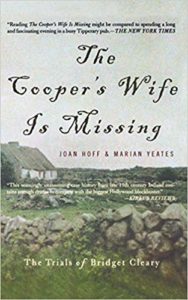 The Cooper’s Wife is Missing: The Trials of Bridget Cleary by Joan Hoff and Marianne Yeates
The Cooper’s Wife is Missing: The Trials of Bridget Cleary by Joan Hoff and Marianne Yeates
I mentioned this title in passing above, as the story of Bridget and Michael Cleary. It’s honestly what really piqued my interest in Irish folklore. The main narrative focuses on Bridget’s murder: I’m overgeneralizing for the sake of synopsis, but essentially, Bridget’s whereabouts were unaccounted for for a couple hours, and when she returned home acting strangely, her husband (Michael) mistook her sickness for a changeling, and he, her neighbors, and her family, all tried to exorcise the fairy from her. This is a work of NONFICTION, and to understand it fully, the authors go in depth about the beliefs of the fairy religion, too. It’s an incredibly well-researched text, and you’ll really love it if you like true crime, too.
 The Changeling by Victor LaValle
The Changeling by Victor LaValle
This contemporary novel is a reimagining of the changeling folklore of Ireland, the idea that fairies inhabit human bodies as a sort of possession. When new father Apollo realizes that his wife and child have disappeared, he goes on a quest to recover them, and on the way, he discovers a whole lot more.
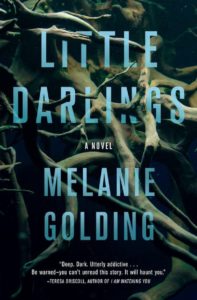 Little Darlings by Melanie Golding
Little Darlings by Melanie Golding
This novel also retells the changeling mythology, but this time from the perspective of the mother. Lauren Tranter is positive that she saw something at her hospital room window after giving birth, a creature who tries to exchange her own creatures with Lauren’s twins. Later, when her twins go missing and then are found, Lauren insists that they are not her children and tries to go about rectifying their hostage state. It’s dangerous, especially if she’s wrong.
 The Good People by Hannah Kent
The Good People by Hannah Kent
I learned who the Good People are from The Trials of Bridget Cleary, and I can tell you, among the fairies, these ones are the ones you want on your team. This novel is based on true events, too. Nora cares for her grandson who can neither speak nor walk, and in her superstitious community, rumors spread that Micheal is a changeling who will bring them bad luck. She bands together with Mary, the handmaid, and Nance, an “elderly wanderer who understands the magic of the old ways” to save the child from the village’s superstitions.
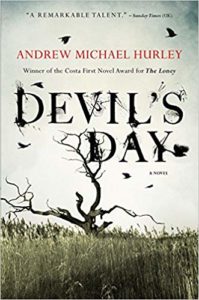 Devil’s Day by Andrew Michael Hurley
Devil’s Day by Andrew Michael Hurley
This novel focuses on the folkloric belief in Northern England (admittedly, not Ireland) of rituals that protect towns from the devil by drawing boundaries. The Gaffer, the one who redraws the villages boundary lines each year, dies the autumn this narrative begins. John Pentecost, his grandson, returns to the farm only to discover as they are burying the Gaffer and bringing the sheep down from the moors, as is custom, that the Endlands may have let the Devil in after all.
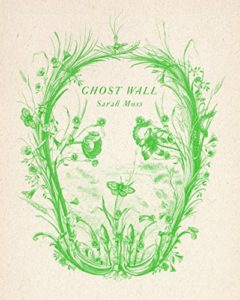 Ghost Wall by Sarah Moss
Ghost Wall by Sarah Moss
This book also takes place in Northern England, but I couldn’t resist including it on the list because of its impeccable folk horror! Silvie, a teenager on summer break, and her family attend an anthropology class’ reimagining of Bronze Age rituals because her father is basically obsessed. As normally happens when people in charge are obsessed with tradition, this reenactment quickly veers off the rails into more horrific territory.
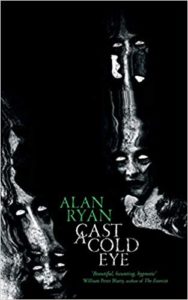 Cast a Cold Eye by Alan Ryan
Cast a Cold Eye by Alan Ryan
This book is less about folklore and more about Irish history, but it’s still a novel full of horrors worth exploring: when American writer Jack Quinlan travels to research the Irish Famine, he quickly notices some odd occurrences, like the hiding of the priest and some weird ritual in the cemetery. Obviously, Jack ends up researching a lot more than just the famine.
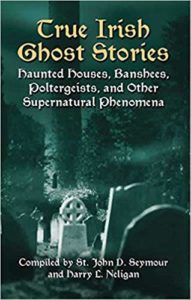 True Irish Ghost Stories by John D. Seymour
True Irish Ghost Stories by John D. Seymour
This anthology has collected early 20th century stories and true events, and they’re divided into chapters including hauntings, poltergeists, and bean sidhes and “other death-warnings.” Though the cover is a little photo-shoppy, the stories inside are bomb–plus, who are we to judge books by their covers?
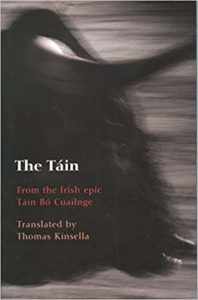 The Tain translated by Thomas Kinsella
The Tain translated by Thomas Kinsella
When I asked my best friend for a recommendation for this list, Sara said, The Tain, which “rhymes with ‘coin.’ (Gaelic, y’all.) The hero has a ‘warp spasm’ that turns his knees backwards and makes him an unbeatable killing machine that can only be stopped by looking at boobs, and the antagonist queen gets her period in battle, and it carves trenches in the earth as deep as a house. Her name is Medb, which rhyme with ‘stave.’ Also the whole war is because the queen found out that the king had one more cow than her, so she went to steal Ireland’s best cow from another country so she would have more riches than the king. There’s one boring chapter that’s just like, listing who’s in the battle, but the rest is dope.” There’s no way I could have paraphrased it any better, so there you go.
News:
A lot of stories about folklore are oral histories commemorated in ways other than literature, so if you want to learn about the Cornish story of a mermaid abducting a preacher’s son, look no further.
This might be literature-adjacent, but did you know that you can spend a night in The Addams Family’s manor?
Ann Napolitano says you should honor your weird obsessions in your writing, and the weirder the better. Learn why here.
Rest in peace, Max von Sydow. (In case your memory needs jogging, the horror community knows this actor best from his portrayal of Father Merrin in the film adaptation of William Peter Blatty’s novel, The Exorcist.)
Stephen King is “uneasy” about “muzzling” authors like Woody Allen.
Looks like another Dracula adaptation is in the works, but this time directed by Karyn Kusama.
Speaking of films, Robert the Doll is the inspiration for both Chucky (of Child’s Play) and Annabelle (of The Conjuring). If you want to know more about him, check out this article. Though it seems that this horror news has little to do with literature, this bit from the link above is really haunting to me: “To date, the walls near his glass case are covered in numerous letters from previous visitors and naysayers, begging for Robert’s forgiveness and asking him to remove any hex he has cast.” YIKES.
While we’re all busy being freaked out by the Corona Virus, we should also acknowledge that from disease like this comes a lot of inspiration for horror writing. Shakespeare himself is known for embracing the plague’s existence in his plays. I wouldn’t exactly call it a silver lining, but the Scottish play wouldn’t be the Scottish play without the plague.
I’m Mary Kay McBrayer, and you can find me on Twitter or Instagram, and this has been The Fright Stuff. If y’all know some good stories about banshees, get at me. But if you ARE a banshee, stay over there.
Until next time, Happy St. Patrick’s Day!
Your Virgil,
Mary Kay McBrayer
Co-host of Book Riot’s literary fiction podcast, Novel Gazing
